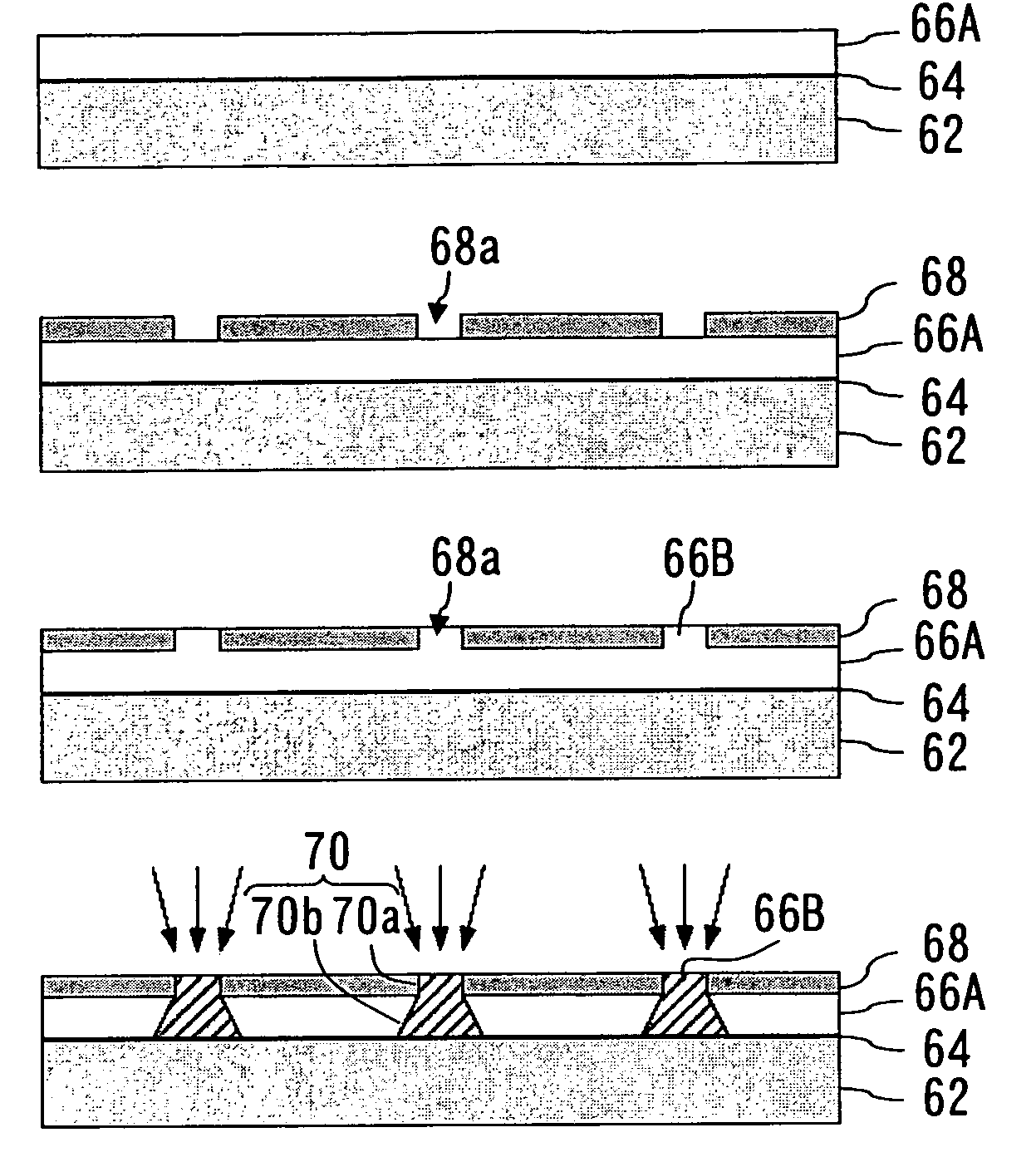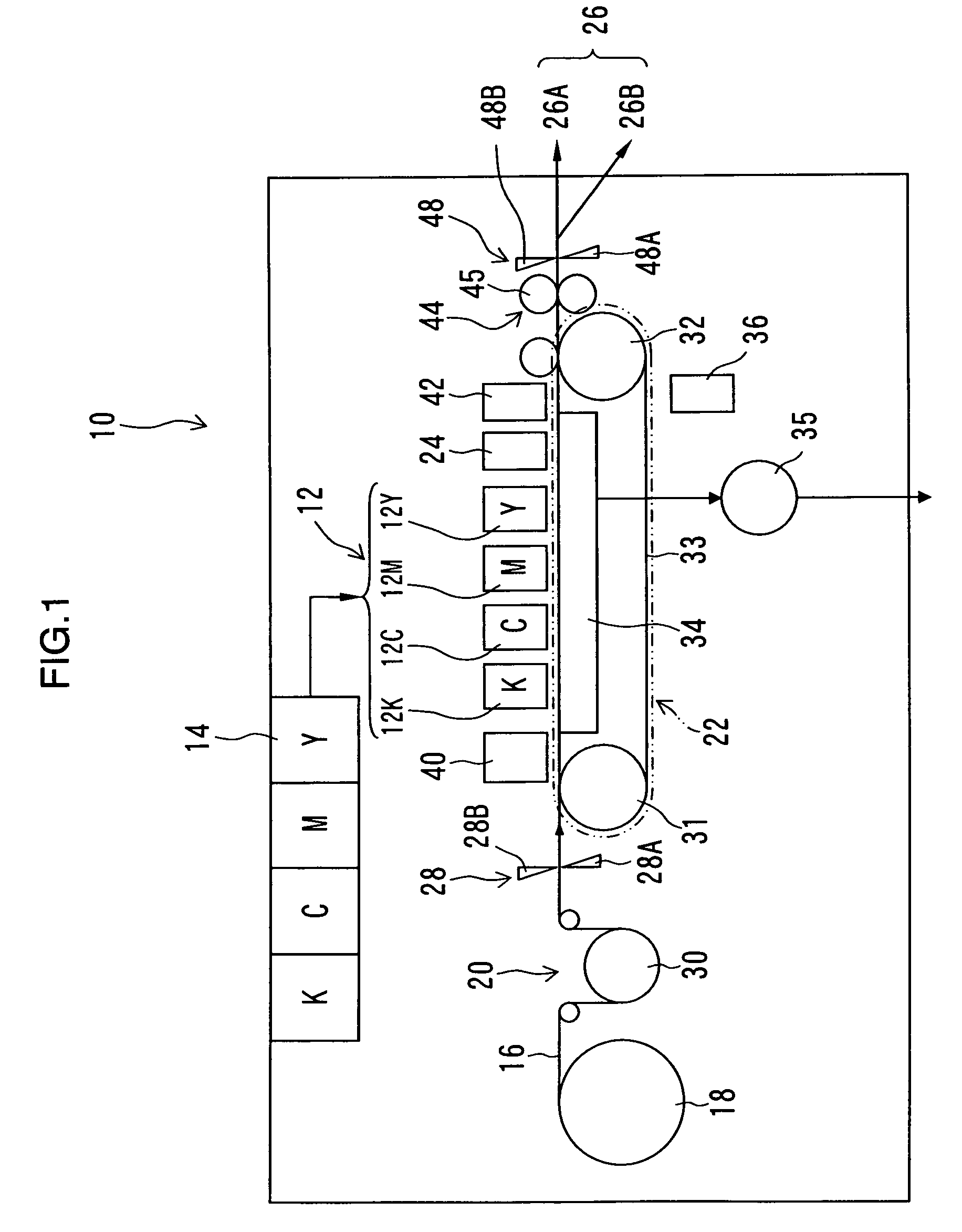Method of manufacturing nozzle plate
a manufacturing method and nozzle technology, applied in the field of nozzle plate manufacturing, can solve the problems of image deterioration, inability to stabilize the ejection direction of the ink, and the ink ejection efficiency may decline, so as to improve the ejection efficiency. , the effect of high degree of accuracy
- Summary
- Abstract
- Description
- Claims
- Application Information
AI Technical Summary
Benefits of technology
Problems solved by technology
Method used
Image
Examples
first embodiment
[0065]FIGS. 4A to 4G are illustrative diagrams showing a method of manufacturing a nozzle plate 60 according to a first embodiment.
[0066]Firstly, as shown in FIG. 4A, a negative resist 66A (nega-type resist: first photosensitive material) is applied onto the conductive film 64 (electrode for electroforming) formed on a matrix 62 (substrate), and the negative resist 66A is pre-baked. Instead of disposing the conductive film 64 on the matrix 62, it is possible to compose the matrix 62 from a conducting material, such as stainless steel. In the present embodiment, a resist 66A in liquid form is used, but it is also possible to use a resist in the form of a film. Next, as shown in FIG. 4B, a straight section forming member 68 is attached onto the resist 66A. The straight section forming member 68 has hole sections 68a which correspond to the straight sections of the nozzles 51. By previously fabricating a straight section forming member 68 by electroforming, it is possible to reuse the ...
second embodiment
[0071]FIGS. 7A to 7C are illustrative diagrams showing a method of manufacturing a nozzle plate 60 according to a second embodiment.
[0072]Firstly, as shown in FIG. 7A, a negative resist 66A is applied onto a conductive film (electrode for electroforming) 64 formed on a matrix 62. Here, in contrast to the first embodiment, pre-baking is not carried out, and the resist 66A is in a liquid state. Next, as shown in FIG. 7B, the straight section forming member 68 is attached onto the resist 66A, and as shown in FIG. 7C, pressure is applied to the straight section forming member 68 and resist 66A is filled into the hole sections 68a of the straight section forming member 68. Thereupon, pre-baking to the resist is carried out. The subsequent processes are the same as the corresponding steps of the first embodiment (see FIGS. 4D to 4G), and hence description thereof is omitted here.
[0073]In the second embodiment, since the straight section forming member 68 is required to be placed on the re...
third embodiment
[0074]FIGS. 8A and 8B are illustrative diagrams showing a method of manufacturing a nozzle plate 60 according to a third embodiment.
[0075]As shown in FIG. 8A, after forming exposure resist sections 70 having a tapered and straight shape on the side of a conductive film 64 disposed on a matrix 62, a metal layer 72 is formed by electroforming. The corresponding steps of the first embodiment are the same as the steps up to this process of the present embodiment (see FIGS. 4A to 4F). Thereupon, as shown in FIG. 8B, eutectoid plating of Ni and PTFE is performed on the surface of the metal layer 72, thereby creating a liquid repellent film 80 on the surface of the metal layer 72. Subsequently, the metal layer 72 including the liquid repellent film 80 is peeled away from the exposure resist sections 70 and the matrix 62 (including the conductive film 64), thereby completing the nozzle plate 60. By forming the liquid repellent film 80 on the surface on the ink ejection side of the nozzle pl...
PUM
| Property | Measurement | Unit |
|---|---|---|
| hole diameter | aaaaa | aaaaa |
| hole diameter | aaaaa | aaaaa |
| thickness | aaaaa | aaaaa |
Abstract
Description
Claims
Application Information
 Login to View More
Login to View More - R&D
- Intellectual Property
- Life Sciences
- Materials
- Tech Scout
- Unparalleled Data Quality
- Higher Quality Content
- 60% Fewer Hallucinations
Browse by: Latest US Patents, China's latest patents, Technical Efficacy Thesaurus, Application Domain, Technology Topic, Popular Technical Reports.
© 2025 PatSnap. All rights reserved.Legal|Privacy policy|Modern Slavery Act Transparency Statement|Sitemap|About US| Contact US: help@patsnap.com



